My SciELO
Services on Demand
Journal
Article
Indicators
-
 Cited by SciELO
Cited by SciELO
Related links
-
 Similars in
SciELO
Similars in
SciELO
Share
Ingeniería Electrónica, Automática y Comunicaciones
On-line version ISSN 1815-5928
EAC vol.39 no.2 La Habana May.-Aug. 2018
ORIGINAL ARTICLE
Assessment of the real public exposure to base stations over a day from instantaneous measurement
Evaluación de la exposición pública real a las estaciones base durante un día a partir de una medición instantánea
Pedro Severo Infante MoreiraI, Fidel GilartII
IEscuela de Ingeniería Electrónica en Telecomunicaciones y Redes, Escuela Superior Politécnica de Chimborazo, Riobamba, Ecuador.
IICentro Nacional de Electromagnetismo Aplicado, Santiago de Cuba, Cuba.
ABSTRACT
The assessment of the real public exposure to signals emitted by base station antennas of mobile telephony over a day from an instantaneous measurementperformed any time during the day is investigated. The considered RF field sources were the mobile communication GSM850 and GSM1900 downlink far-field signals received in an outdoor fixed site in an urban environment. Two traffic channels were analyzed: Ch133 (870.2 MHz), corresponding to the GSM850 and Ch674 (1962.6 MHz), corresponding to the GSM1900. A mathematical model, based on the mean value Ē(t) and the standard deviation σE (t) of the instantaneous electric field intensity E(t), was proposed for predicting the maximum electric field exposure Emax over a day for a week starting from an instantaneous measurement. The results of assessment of the maximum electric field exposure using this method were compared with those obtained using another method recently proposed by other authors, and it was shown that they can be more realistic.
Key words: electromagnetic measurement; long term RF exposure of general public.
RESUMEN
En este trabajo se investiga la evaluación de la exposición pública diaria real a las señales emitidas por las antenas de las estaciones base de telefonía celular a partir de una medición instantánea realizada en cualquier momento durante el día. Las señales de RF consideradas son las de campo lejano de los enlaces descendientes GSM850 y GSM1900 de las comunicaciones móviles en un lugar exterior fijo en un medio urbano. Se analizaron dos canales de tráfico: Ch133 (870.2 MHz), correspondiente a la GSM850 y Ch674 (1962.6 MHz) correspondiente a la GSM1900. Se propuso un modelo matemático basado en el valor medio Ē(t) y la desviación estándar σE (t)de la intensidad del campo eléctrico instantánea E(t) para predecir la máxima exposición diaria al campo eléctrico Emaxpara una semana a partir de una medición instantánea. Los resultados de la evaluación de la máxima exposición al campo eléctrico usando este método fueron comparados con los obtenidos usando otro método propuesto recientemente por otros autores y se demostró que ellos pueden ser más realistas.
Palabras claves: mediciones electromagnéticas; exposición de RF de largo plazo del público general.
1. INTRODUCTION
In recent years, there has been an increasing public concern about possible health hazards due to exposure to radiofrequency (RF) electromagnetic fields. Accordingly, many international protection organizations and regulatory agencies have proposed safety standards for exposure to such fields. These standards are based on the SAR, a measure of the electromagnetic power absorbed in the tissue, which is proportional to the square of the internal electric field intensity and depends, among other factors, on the incident electric field intensity and frequency.In this context, characterizing and regulating RF human exposure to signals emitted by base station antennas (BSA) of mobile communication systems has reached a great interest from environmental and epidemiological points of view. These signals have a great variability in time depending on the amount of communication traffic, on the radio propagation conditions and on some specific functionalities such as the power control. It has been shown [1] that a measurement at a certain time instance or a measurement in a fixed position in space may not be representative for time or spatially averaged exposure, or for the maximum exposure assessment of BSA emissions. However, up to now most of the exposure assessment was made on the short term, as shown by Joseph et al. [2] and by Genc et al. [3].
In exposure standards [4, 5] the field-level variability in the vicinityof base stations is solved by simply extrapolating the field in the pilot channel (BCCH for GSM, and CPICH for UMTS and HSDPA) for all transmitters (worst-case scenario) of a base station. The worst-case assessment is adopted by some countries intending to ensure reliable and reproducible exposure assessments in varying traffic conditions, which guarantees the compliance. But this method, besides leading to consistent overestimation of the electromagnetic field level throughout the downlink spectrum, does not take in consideration the fluctuations of the signals and does not allowdetermining the electric-field exposure at a time instant from the electric-field measurements at another time instant.
Several authors recently investigated the temporal variations of the signals emitted by cellular BSA [6-23] and some proposed measurement procedures that allow extrapolations of maximum exposure from measurement results obtained over short time periods [6–8, 10, 11, 16].
In [6, 7], a method was proposed to calculate the maximum electric field intensity during 24 h (1 d) from the momentary total measured electric-field value (pilot signal and traffic signals together) using the corresponding Erlang data (average traffic intensity or channel occupancy) for GSM. It was shown that the exposure over 24 h is highly variable, being maximum between 9 am and 8 pm and minimum between 12 am and 6 am. They also showed that there are differences between weekdays and weekends regarding exposure levels. This method has the following weaknesses: (1) - the application of the procedure requires information on traffic values (Erlang values) from the GSM operators directly, which is disadvantageous, (2) - the extrapolation factors based on the Erlang data are insensible to the effects of the multipath fading of the radio-link on the detected signals, (3) - the predicted values of the maximal electric field intensity over a day starting from different instantaneous measurements are different, (4) - the divergences between the expected and the predicted values of the maximum exposure increase with the range of temporal variationsthroughout the day, (5) -the time interval for which the extrapolation factors can be calculated corresponds to typical working hours during which control agencies can make their measurements.
In [9] the problem of time-variability of GSM signals was approached. Based on measurements performed during 1-d periods in different locations of France and Poland, authors demonstrated that for the 50% of all the measurements in urban areas and for the 100% of all the measurements in the rural areas the distribution of the signals can be modeled by a mixture of three Gaussians, representing the night hours, work hours and rush hours. In this respect, the authors of [15] reported that the validation of three Gaussians model by theirs results for an urban location in Romania failed.
In [10, 11, 16] a method with two variants was presented for estimating the maximum electric field exposure during a day starting from an instantaneous measurement using two types of extrapolation factors. The first variant of the method is based on the measurement of the pilot signal (BCCH or CPICH) and uses an extrapolation factor called the number of equivalent transmitters and defined as the ratio between the electric field intensity (power density) corresponding to all the traffic channels and the electric field intensity (power density) of the pilot channel. The second variant of the method is based on the measurement of the traffic signal and uses an extrapolation factor defined as the ratio between the maximum electric field intensity (power density) over a day and the instantaneous value of the electric field intensity (power density). For each of the time intervals representing the night hours, work hours and rush hours in the three Gaussians model, probability density functions (PDF) were established for traffic fluctuations, in order to finally predict the maximal electric field exposure during one day starting from an instantaneous measurement, using the first variant of the method. It was reported that the instantaneous combined power density from a cell varies by ± 4.5 dB throughout the day as a result of traffic variation. Based on the maximal number of equivalent transmitters they demonstrated that for GSM and UMTS systems in a realistic environment a full traffic situation is never reached in reality, and that in this case the safety standards that have been developed to check the compliance with safety limits overestimate the real exposure. This method has the following weaknesses: (1) - the predicted values of the maximal electric field intensity over a day starting from different instantaneous measurements are different, (2) - the divergences between the expected and the predicted values of the maximum exposure increase with the range of temporal variations throughout the day, (3) - the complex time-variability of the electric field over 24 h is modeled in a very simple way using four line segments, (4) the distribution of the signals not always can be modeled by a mixture of three Gaussians.
In conclusion, the existing methods for estimating the maximum electric field exposure during a day from a measurement accomplished over a short time period have deficiencies that prevent the obtaining of more realistic results. The objective of this paper is to present an alternative method that can lead to better results.
2. MATERIALS AND METHODS
The electric fields were measured using a Narda SRM 3000 Selective Radiation Meter. The sensor was a tri-axial isotropic antenna from Narda (dynamic range of 0.25 mV/m to 200 V/m and a frequency range of 75 MHz to 3 GHz). The basic unit of this meter contains a spectrum analyzer for the 100 kHz to 3 GHz frequency range. For the considered setup, the measurement expanded uncertainty, evaluated using a confidence interval of 95%, was +2.4/-3.3 dB.
The considered RF field sources were the mobile communication GSM850 and GSM1900 downlink far-field signals received in an outdoor fixed site in an urban environment. Two traffic channels were analyzed: Ch133 (870.2 MHz), corresponding to the GSM850 and Ch674 (1962.6 MHz), corresponding to the GSM1900. For the whole measurement campaign, the receiver antenna was positioned and fixed at a height of 1.5 m above the ground, in the line of sight with the BSA. The meter was operated in the spectrum analyzer mode with a resolution bandwidth (RBW) of 30 kHz and the measurements were done every 10 s using the RMS detector. An averaging time of 6 minutes was applied to all measurements. Each channel was monitored/measured continuously during two successive weeks.
3. RESULTS AND DISCUSSION
The mean value and the standard deviation of the instantaneous electric field intensity E(t) were determined and the resulting data vectors were smoothed using the moving average method. After this, a Fourier series with 7 harmonics was fitted to the smoothed data and the obtained vectors were represented as Ē(t) and σE(t). For the electric field intensity and its standard deviation the following extrapolation factors were defined:
where Emp (t) is the most probable value of the E(t) for a given day of the week.
The maximum value of the electric field intensity over a day for a week can be expressed as (see Figure 1):
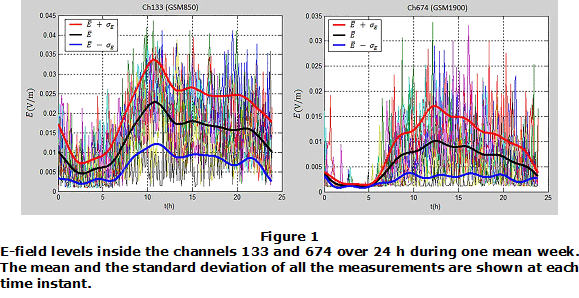
Combining (1), (3) and (6) we obtain
This leads, with the aid of (5), to
where Emp (t) was replaced with E(t).
From (8) it is inferred that, if for a given signal the ƒmm (t), ƒEE (t) and ƒσE (t) extrapolation factors are known, it is possible to predict for that signal the maximum electric field exposure Emax over a day from a measurement of E(t). From (1) it is inferred that, if the ƒEE (t) extrapolation factor and Emax are known, it is possible to predict Ē(t). Finally, from (2) it is inferred that, if the ƒEσ (t) extrapolation factor and Emax are known, it is possible to predict σE (t).
The expressions (8), (1) and (2) constitute the basis of the mathematical model developed in this work for the prediction of the long term public exposure starting from the short term measurement of the field. Using the definitions of ƒEE (t), ƒEσ (t), ƒσE (t) and ƒσσ (t) it can be shown that
For the measured GSM850 signal c=2,1047, whereas for the measured GSM1900 signal c=1,4797.
Figure 1 shows the variation of the electric field intensity E(t) over 24 h for the channels 133 and 674 due to variations in traffic. It can be clearly seen that during the night there is only little active traffic while during the day both the variability and traffic are higher.
From the perspective of the traffic habits, four time intervals that are repetitive during a week can be separated in the graphs: night hours (01:00 - 06:00), early-morning hours (06:00 - 09:00), work hours (09:00 - 21:00) and rest hours (21:00 - 01:00). None of our measurements showed an exceeding of the limits given in [24] for human protection, furthermore they were far beyond those limits. Our footprints of the field-levels over 24 h are very similar in shape to those obtained by other authors [9, 11, 13-15, 17, 19].
In Figures 2, 3, 4 three of the defined extrapolation factors for the studied GSM signals are shown. Taking into account the small size of the E(t) gathered samples in this work for the same day of the week, when calculating the ƒmm (t) extrapolation factors the most probable value Emp (t) was considered equal to the mean value of E(t) for the given day.
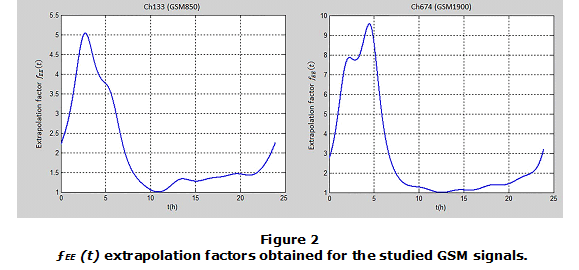
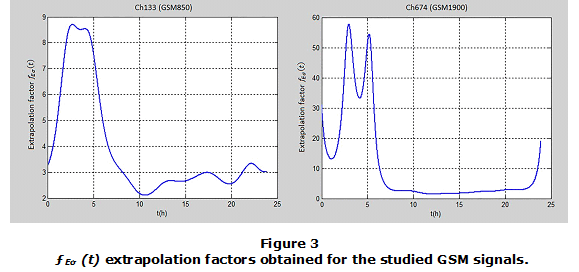
![Figure 4. [������(��)]������ extrapolation factors corresponding to Wednesday obtained for the studied GSM signals.](/img/revistas/eac/v39n2/f0401218.gif)
The curves shown in Figure 4 were smoothed using the moving average method. In the case of bigger E(t) samples for the same day of the week, Emp (t) could be determined from the probability density function (PDF) of E(t), and the daily variations of the ƒmm (t) extrapolation factors would be smoother.
Due to the environmental changes, to the operative and/or technological changes in the base stations, as well as to the changes in the local human communication habits, the valid extrapolation factors ƒmm (t), ƒEE (t), ƒEσ (t), ƒσE (t) and ƒσσ (t) for a given location and signal must be updated every so often.
Next, using the results of the measurements of the electric field intensity carried out in this work, the second variant of the method proposed in [10, 11, 16], based on the measurement of the traffic signal, and the method based on the mathematical model proposed here for the prediction of the maximum electric field exposure during a day from the momentary electric field value will be compared.
In Figure 5 cumulative density function (CDF) of the extrapolation factor ƒE (t)≡Emax⁄E(t), obtained from the processing of the E(t) data, corresponding to the channel 133 (GSM850), is shown.
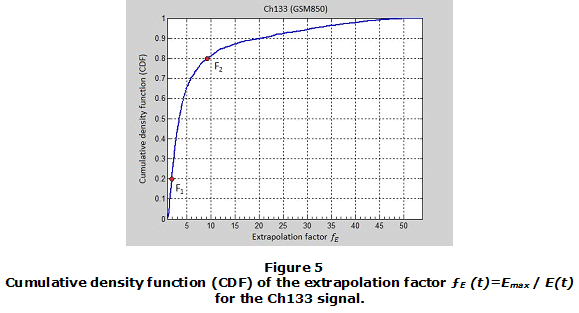
The extrapolation factor corresponding to the point F1 [ƒE1=1.9629] was determined from ƒE1=Emax/Ep80, where Ep80is the 80th percentile of the E(t) data, whereas the extrapolation factor corresponding to the point F2 [ƒE2=9.2695] was determined from ƒE2=Emax/Ep20, where Ep20 is the 20th percentile of the mentioned data.
In Figure 6 the corresponding model for the daily temporal variation of the extrapolation factor ƒE (t), using only the two selected limiting values ƒE1 and ƒE2 is shown.
![Figure 6. ����(��) extrapolation factor for the Ch133 signal, based on the prediction method proposed in [10, 11, 16].](/img/revistas/eac/v39n2/f0601218.gif)
According to the method proposed in [10, 11, 16], the expected maximum value of the electric field intensity for a week in a given location can be predicted from an instantaneous measurement of the electric field intensity, accomplished on any day of that week in the same location, using
where, in this case, ƒE (t) would take the value ƒE2=9.2695 between the 00:00 h and the 06:00 h, and the value ƒE1=1.9629 between the 12:00 h and the 21:00 h, as it is shown in Figure 6.
In Figure 7 the temporal variation over 24 h of the measured Ch133 signal, as well as the real value of Emax and the predicted one, derived from the measured values of E(t) with a step of one hour during two different days of the week (Wednesday and Friday) and the application of the method proposed in [10, 11, 16] are shown.
![Figure 7. Measured Ch133 signal and comparison of the real value of �������� with the predicted one by the method proposed in [10, 11, 16], using the values of ��(��) measured during two different days of the week (Wednesday and Friday).](/img/revistas/eac/v39n2/f0701218.gif)
It can be seen, that the best prediction of Emax are achieved when the measurements of the electric field intensity are accomplished between the 12:00 h and the 21:00 h (high traffic hours). Since in the method proposed in [10, 11, 16] the measurements of the field level may be accomplished on any day of the week and on any time instant during the 24 hours of the day, it is inferred that the prediction of the maximum exposure by this method can be unrealistic.
In Figure 8 the temporal variations over 24 h of the measured Ch133 signal, as well as the predicted values of Emax for a week from the measured values of E(t) on Wednesday by means of the application of the method proposed in this work are shown. In this case the predicted value of Emax for a week has a mean of 0.0228 V/m and it is included between 0.0120 V/m and 0.0337 V/m, as determined by the standard deviation.
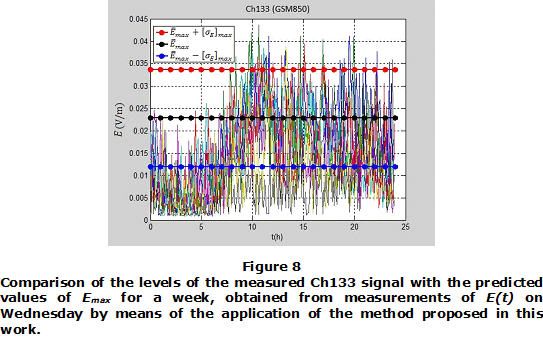
It should be noticed that, contrary to the method proposed in [10, 11, 16], in the method proposed in this work the predicted value of Emax for a week is independent of the day of the week and of the time instant at which the measurements of E(t) are carried out. Besides, the specification of the maximum exposure is done by means of the mean value of Emax for a week and the corresponding standard deviation, which has a bigger statistical value than when this is done by means of the absolute value of Emax for one day or for one week.
The comparison of the two considered prediction methods using the data of the measured Ch674 (GSM1900) signal, leads to similar results.
Besides modeling the characteristic footprint of the temporary variation of the field over 24 h in a very simplified way using four line segments, another important disadvantage of the method proposed in [10, 11, 16] is that the result of the prediction is very sensitive to the data dispersion and to the shape of the distribution of the signals.
An important result of this work is that the daily temporal variability of the measured electric field intensity [20×log(Emax⁄Emin)] for the studied GSM 850 and GSM 1900 signals was ± 34,6 dB and ± 30,7 dB, respectively, values that are much higher that others reported in the literature for measurements carried out in mobile telephony networks of other countries (± 9,0 dB for a GSM 900 signal in France [11], ± 5,1 dB for a GSM 900 signal and ± 9,9 dB for a GSM 1800 signal in Belgium [19], ± 21,6 dB for a GSM 900 signal in Romania [14]). This enhances the advantage of the prediction method proposed here, a method that allows predicting the long term public exposure starting from the short term measurements of the field level more realistically, in comparison with that proposed in [10, 11, 16].
Another result of this work is that the probability density functions (PDF) of the measured GSM850 and GSM1900 signals cannot be modeled by a mixture of three Gaussians, as it can be seen from Figure 9.This disables the application of the first variant of the prediction method proposed in [10, 11, 16], based on the measurement of the pilot signal (BCCH or CPICH). As in [25], here the measured E(t) levels were statistically different with respect to days of the week and their distribution was best modeled with non-parametric fits.
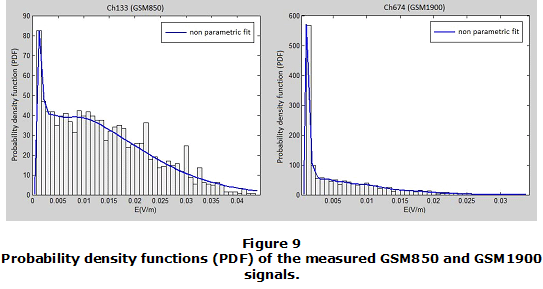
4. CONCLUSIONS AND FUTURE WORK
A mathematical model, based on the mean value Ē(t) and the standard deviation σE (t) of the instantaneous electric field intensity E(t), was proposed for predicting the maximum electric field exposure Emax over a day for a week starting from an instantaneous measurement. The results of the assessment of the real public exposure to base stations emissions over a day from instantaneous measurement using this method were compared with those obtained using another method recently proposed by other authors, and it was shown that they can be more realistic.
This work is of interest for elaborating standards of exposure based on measurements in operating systems to assess the real long term human exposure to cellular networks.
In a future work the effects of the fmm (t) extrapolation factors on the prediction results will be deeply investigated.
5. REFERENCES
1. Bornkessel C, Schubert M, Wuschek M and Schmidt P. “Measurement and calculation of general public electromagnetic exposure around GSM and UMTS cellular base stations.” In: Proceedings of Second International ITG Conference on Antennas INICA’07. INICA, 2007, p. 225-229.
2. Joseph W, Verloock L, Tanghe E and Martens L. “In-situ measurement procedures for temporal RF electro-magnetic field exposure of the general public”. Health Phys. 2009; 96:529 -542.
3. Genc O, Bayrak M and Yaldiz E. Analysis of the effects of GSM bands to the electromagnetic pollution in the RF spectrum. Progress in Electromagnetics Research. 2010; 101:17-32.
4. EN 50492-2008 (R2014). “Basic standard for the in-situ measurement of electromagnetic field strength related to human exposure in the vicinity of base stations,” European Committee for Electrotechnical Standardization (CENELEC), Brussels.
5. Electronic Communications Committee (ECC) 2004. “Measuring non-ionizing electromagnetic radiation 99 kHz–300 GHz.” Proc. European Conf. of Postal and Telecommunications Administrations (Copenhagen) Recommendation 02(04).
6. Joseph W, Verloock L, Tanghe E, Martens L. “In-situ measurement procedures for temporal RF electromagnetic field exposure of the general public,” Health physics. 2009; 96(5):529-42.
7. Joseph W, Verloock L. “Influence of mobile phone traffic on base station exposure of the general public,” Health Physics. 2010; 99:631-638.
8. Joseph W, Verloock L, Goeminne F, Vermeeren G, Martens L. “Assessment of general public exposure to LTE and RF sources present in an urban environment”, Bioelectromagnetics. 2010; 31(7):576-579.
9. Mahfouz Z, “Statistical Analysis of Real Radiofrequencies Exposure in a Realistic Environment,” Published in: Microwave Symposium (MMS), 2010 Mediterranean, Publisher: IEEE, DOI: 10.1109/MMW.2010.5605158.
10. Mahfouz Z, Gati A, Lautru D, Wiart J, and Hanna VF. “Assessment of the Real Life Exposure to 2G and 3G Base Stations Over a Day from Instantaneous Measurement,” Published in: General Assembly and Scientific Symposium, 2011 XXXth URSI, Publisher: IEEE, DOI: 10.1109/URSIGASS.2011.
11. Mahfouz Z, Gati A, Lautru D, Man-Fai Wong, Wiart J, and Hanna VF, “Influence of Traffic Variations on Exposure to Wireless Signals in Realistic Environments,” Bioelectromagnetics. 2012; 33:288-297.
12. Manassas A, Boursianis A, Samaras T and Sahalos JN. “Continuous electromagnetic radiation monitoring in the environment: analysis of the results in Greece,” Radiation Protection Dosimetry. 2012; 151(3):437-442.
13. Bechet P and Miclaus S. “An improved procedure to accurately assess the variability of the exposure to electromagnetic radiation emitted by GSM base station antennas,” Measurement Science & Technology. 2013; 24(015003):1-9.
14. Miclaus S, Bechet P and Gheorghevici M. “Long-term exposure to mobile communication radiation: an analysis of time-variability of electric field level in gsm900 downlink channels,” Radiation Protection Dosimetry. 2013; 154(2):164-173.
15. Miclaus S, Bechet P and Iftode C. “The application of a channel-individualized method for assessing long-term, realistic exposure to radiofrequency radiation emitted by mobile communication base station antennas,” Measurement. 2013; 46:1355-1362.
16. Mahfouz Z, Verloock L, Joseph W, Tanghe E, Gati A, Wiart J, et al. “Comparison of temporal realistic telecommunication base station exposure with worst-case estimation in two countries,” Radiation Protection Dosimetry. 2013; 157(3):331-338.
17. Vermeeren G, Markakis I, Goeminne F, Samaras T, Martens L, Joseph W. “Spatial and Temporal RF Electromagnetic Field Exposure of Children and Adults in Indoor Micro Environments in Belgium and Greece,” Progress in Biophysics and Molecular Biology. 2013; 113(2):254-263, DOI: http://dx.doi.org/10.1016/j.pbiomolbio.2013.07.002.
18. Colombi D, Thors B, Wirén N, Larsson LE, and Törnevik C. “Measurements of downlink power level distributions in LTE networks,” in Proc. Int. Conf. Electromagn. Adv. Appl. (ICEAA), Turin, Italy, Sep. 2013, p. 98-101.
19. Verloock L, Joseph W, Goeminne F, Martens L, Verlaek M, and Constandt Kim. “Temporal 24-hour Assessment of Radio Frequency Exposure in Schools and Homes,” Measurements. 2014; 56:50-57.
20. Bürgi A, Scanferla D, and Lehmann H. “Time averaged transmitter power and exposure to electromagnetic fields from mobile phone base stations,” International Journal of Environmental Research. Public Health. 2014; 11(8):8025-8037.
21. Strappini M, Angelucci M, Vecchiocattivi M, Gianola P, Scotti R, Villani V, et al. “A Procedure for Estimation on the Electromagnetic Field Exposure Levels,” XX Riunione Nazionale di Elettromagnetismo (RINEM), Padova, 15-18 settembre 2014.
22. Qing Qing He, Wan Chun Yang, and Yan Xia Hu. “Accurate Method to Estimate EM Radiation from a GSM Base Station,” Progress In Electromagnetics Research M. 2014; 34:19-27.
23. Joshi P, Agrawal M, Thors B, Colombi D, Kumar A, and Törnevik Ch. “Power Level Distributions of Radio Base Station Equipment and User Devices in a 3G Mobile Communication Network in India and the Impact on Assessments of Realistic RF EMF Exposure,” IEEE Access. 2015; 3:1051-1059.
24. ICNIRP, “Guidelines for limiting exposure to time-varying electric, magnetic, and electromagnetic fields (up to 300 GHz),” Health Physics. 1998; 74(4):494-522.
25. Engiz BK and Kurnaz C. “Long-term electromagnetic field measurement and assessment for a shopping mall”, Radiation Protection Dosimetry. 2016:1-9,DOI:10.1093/rpd/ncw34 3.
Received: 16/10/2017
Approved: 5/2/2018
Pedro Severo Infante Moreira, Electronic Engineer from the Escuela Superior Politécnica del Litoral, Guayaquil Ecuador, Professor, Escuela de Ingeniería Electrónica en Telecomunicaciones y Redes, Escuela Superior Politécnica de Chimborazo, Riobamba, Ecuador, E-mail: pinfante@espoch.edu.ec.His main research interests are in the interaction between nonionizing electromagnetic radiation and biological systems.














